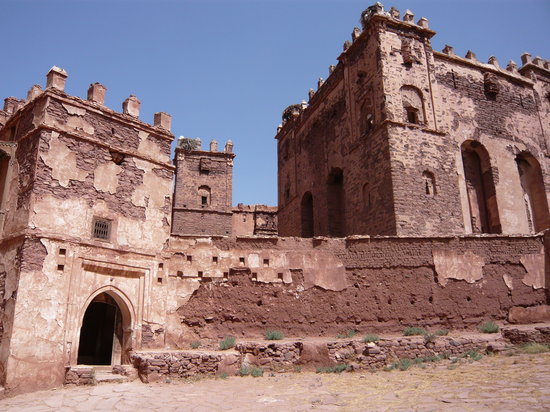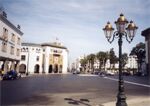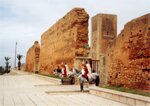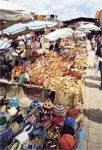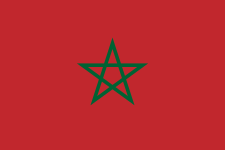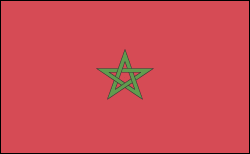Moroccan Flag

The Flag of Morocco - Description of the Moroccan Flag
As the above picture of the Moroccan Flag indicates the overall background is Red
The description of the Moroccan Flag is as follows:
Red with a green pentacle (five-pointed, linear star) known as Solomon's seal in the center of the flag green is the traditional color of Islam
According to Ancient and Heraldic traditions much symbolism is associated with colors. The colors on the Moroccan flag represent the following:
Red - hardiness, bravery, strength & valour
Green - hope, joy and love and in many cultures have a sacred significance and is is the traditional color of Islam
The basic style shown in the picture of the Moroccan flag is described as Emblem -reflecting the central design of the flag pattern
All Flag pictures depict flags flying, from the viewer's point of view, from left to right
The shape and flag ratio of the Moroccan flag is described as 2:3 ( length 1½ times the height )
The Meaning & History of the Moroccan Flag - The Moroccan emblem depicts the green Sulayman star and was introduced in 1912, when Morocco was placed under French protectorate
The pentagram is usually known as King Solomon's Seal, while the hexagram is known as the Star of David
Flag Terminology - Did you Know ?
The design and description uses specific flag terminology based on Heraldic principles
Animal blazons should always appear with the heads facing the flag - staff side
The Study of the Flags is called Vexillology
Your interest in flags makes you a Vexillologist!
Increase your knowledge - Play the Flag Quiz
Flag History & Evolution:
The idea of flying a flag grew from the requirements of ancient warfare and the battlefield
Shields were painted with emblems to identify Friend or Foe
Warriors needed to know where their leaders were - the custom of carrying a pole was adopted
An emblem such as a shield, animal or religious device was attached to the pole for identification
The emblems were also used for identity and to cover suits of armour - Coats of Arms were born
These emblems were the forerunners of modern flags
The Romans were the first to use a cloth flag - they were square and fastened to cross bars at the end of spears - the idea of fastening a flag to the side of a pole soon followed
The strict rules of Heraldry are still used when designing an emblem and creating a modern flag
Moroccan Flag Etiquette
Moroccan Flag etiquette is very strict and is is essential that Flag protocols and rules are followed correctly
Basic Flag Etiquette applies to all nations, including Moroccan as follows:
Etiquette relating to the order of precedence for the flag
National Flag of Moroccan
State Flag of Moroccan
Military Flag of Moroccan (in order of creation date)
Other Flag of Moroccan
The United Nations uses alphabetical order when presenting a national flag including the Moroccan Flag. Their flag etiquette ensures that no one country's flag has precedence over another country's flag
The National flag of Moroccan should never be flown above another national flag on the same staff as this would suggest superiority, or conversely, inferiority of one flag, or Nation, over another
The Moroccan flag should never be allowed to drag along the ground
A tattered or faded flag of Moroccan should be removed and replaced with a new flag
Due care and consideration must be taken to ensure that the Moroccan flag is always flown the correct way up
A Flag of Moroccan, when in such condition that it is no longer a fitting emblem of display, should be destroyed in a dignified way, preferably by burning in private with all due care and respect
Terminology & Etiquette in Moroccan Flag display
Hoist - the act or function of raising the Moroccan flag, as on a rope
Half Staff or Half Mast - the Moroccan flag is hoisted to half of the potential height of the flag pole to denote grief and mourning
Performed by first raising the Moroccan flag to the top, then lowering the Moroccan Flag halfway
Distress - denoted by flying the Moroccan flag upside-down
Manner of hoisting - The Moroccan flag should be hoisted briskly and lowered ceremoniously
No disrespect should be shown to the Moroccan flag
The Moroccan flag should never be fastened, displayed, used, or stored in such a manner as to permit the Flag to be easily torn, soiled, or damaged in any way
The Moroccan flag should never have placed upon it, nor on any part of it, nor attached to it any mark, insignia, letter, word, figure, design, picture, or drawing on the flag of any nature
The Moroccan flag should be hoisted first and lowered last
International Flag relating to Moroccan Flag usage forbids the display of the flag of one nation above that of another nation in time of peace
We hope that the presentation of facts and information regarding Moroccan Flag Etiquette has provided a useful resource
morocco culture,moroccan food,morocco food,moroccan cuisine,morocco beaches,moroccan meal,beaches in morocco,moroccan culture,hercules cave,hercules cave morocco














